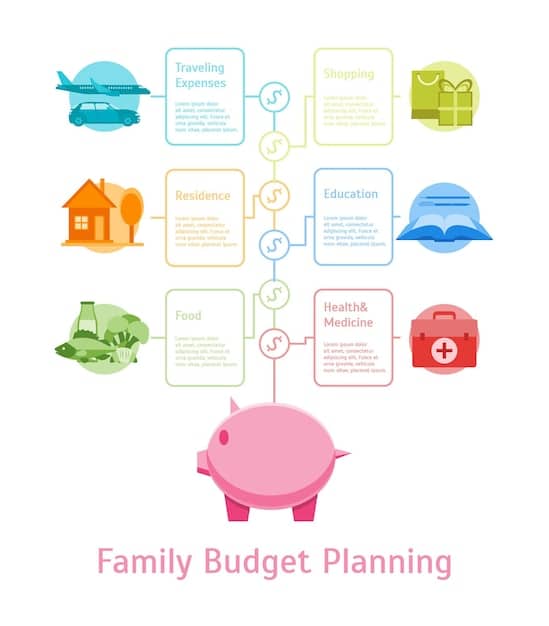Child Tax Credit 2025: Rules, Eligibility & How to Claim

Understanding the Child Tax Credit (CTC) for 2025 is crucial for eligible US families to maximize their benefits; this guide clarifies the rules, eligibility criteria, and the process for claiming the full amount.
Navigating the complexities of the US tax system can be daunting, especially when it comes to benefits like the Child Tax Credit: Understanding the 2025 Rules and Claiming the Full Amount is vital for ensuring you receive the maximum support available for your family.
What is the Child Tax Credit and How Does it Work?
The Child Tax Credit (CTC) is a U.S. government program designed to help families with the costs of raising children. It provides a tax credit for each qualifying child, reducing the amount of tax a family owes. Understanding how this credit works is crucial for benefiting fully from it.
The Child Tax Credit aims to alleviate the financial burden on families, allowing them to better provide for their children’s needs. The credit can be claimed during tax season, helping families manage their expenses and improve their overall financial well-being.
Eligibility Criteria for the Child Tax Credit
To be eligible for the Child Tax Credit, several criteria must be met. These criteria primarily revolve around the child’s age and relationship to the taxpayer. Let’s delve deeper into these requirements.
- Age Requirement: The child must be under 17 years old at the end of the tax year.
- Relationship: The child must be the taxpayer’s son, daughter, stepchild, foster child, brother, sister, stepbrother, stepsister, half-brother, half-sister, or a descendant of any of them (e.g., grandchild, niece, nephew).
- Residency: The child must live with the taxpayer for more than half the tax year.
- Dependency: The taxpayer must claim the child as a dependent on their tax return.

How the Credit Amount is Determined
The amount of the Child Tax Credit a family can receive depends on several factors, including their income and the number of qualifying children they have. Understanding these factors can help families estimate their potential credit amount.
The maximum credit amount can vary from year to year, as it may be subject to legislative changes. Staying informed about the latest updates ensures families can take full advantage of the available credit.
In summary, the Child Tax Credit is a valuable resource for families raising children, providing financial relief and stability. Understanding the eligibility criteria and how the credit amount is determined is essential for maximizing its benefits.
Key Changes and Updates for the 2025 Child Tax Credit
As tax laws evolve, so do the rules governing the Child Tax Credit. Staying informed about the key changes and updates for the 2025 tax year is crucial for eligible families.
These changes can impact eligibility criteria, credit amounts, and how the credit is claimed. It’s essential to understand these updates to ensure accurate tax filings and to maximize potential benefits.
Some of the potential adjustments may be focused on income thresholds, credit phase-out rates, or even the definition of a qualifying child. Monitoring these changes is key for effective tax planning.
Potential Legislative Adjustments
Legislative bodies frequently review and modify tax laws, and the Child Tax Credit is no exception. Understanding these adjustments can help families prepare for any changes in their tax obligations and potential benefits.
Legislative changes can arise from various factors, including economic conditions, policy priorities, and budgetary constraints. These changes may have both short-term and long-term impacts on families.
- Changes to Income Thresholds: Income thresholds may be adjusted to reflect changes in the cost of living or to target the credit to specific income groups.
- Modifications to Credit Amount: The maximum credit amount may be increased or decreased based on budgetary considerations.
- Adjustments to Eligibility Criteria: Eligibility rules, such as the age limit for qualifying children, may be modified.
- Inclusion of New Provisions: New provisions may be added to address specific needs or to align the credit with other tax policies.
Economic Factors Influencing the Credit
Economic conditions play a significant role in determining the parameters of the Child Tax Credit. Understanding these factors can help families anticipate potential changes and plan accordingly.
Economic factors such as inflation, unemployment rates, and overall economic growth can influence legislative decisions regarding the Child Tax Credit.
In conclusion, staying informed about the key changes and updates for the 2025 Child Tax Credit is essential for maximizing its benefits. Keeping an eye on potential legislative adjustments and economic factors can help families plan effectively.
Eligibility Requirements in Detail
To successfully claim the Child Tax Credit, it’s essential to meet specific eligibility requirements. These requirements cover various aspects, including the child’s age, relationship to the taxpayer, and residency.
Understanding these requirements in detail ensures that families can accurately determine their eligibility and avoid potential issues during tax season. Each requirement is designed to target the credit to specific families and children.
Meeting all the eligibility requirements is crucial for claiming the Child Tax Credit. Failure to meet any of the criteria may result in ineligibility for the credit.
Age and Dependency Criteria
The age and dependency criteria are fundamental aspects of determining eligibility for the Child Tax Credit. These criteria ensure that the credit is targeted towards families supporting minor children.
The child’s age must be under 17 at the end of the tax year. Additionally, the child must be claimed as a dependent on the taxpayer’s tax return.
- Age Limit: The child must be under 17 years old as of December 31st of the tax year.
- Dependent Status: The child must be claimed as a dependent on the taxpayer’s federal income tax return.
- Not Self-Supporting: The child cannot provide more than half of their own financial support.
- Citizenship: The child must be a U.S. citizen, U.S. national, or U.S. resident alien.
Residency and Relationship Rules
The residency and relationship rules further refine the eligibility criteria for the Child Tax Credit. These rules ensure that the credit is claimed by taxpayers who have a close connection to the child.
The child must live with the taxpayer for more than half of the tax year. The child must also be related to the taxpayer in a specific way, such as a son, daughter, stepchild, or sibling.
In summary, understanding the eligibility requirements in detail is critical for successfully claiming the Child Tax Credit. Paying close attention to the age, dependency, residency, and relationship rules ensures that families can accurately determine their eligibility.

Maximizing Your Child Tax Credit in 2025
To make the most of the Child Tax Credit in 2025, it’s essential to understand the factors that affect the credit amount and to take steps to maximize it. This can involve careful tax planning and record-keeping.
Families can maximize their Child Tax Credit by ensuring they meet all eligibility requirements and by accurately reporting their income and expenses. This can help them receive the full credit amount they are entitled to.
Staying informed about any changes to the Child Tax Credit rules and regulations can also help families maximize their benefits. Tax laws can change, so it’s important to stay up-to-date.
Strategies for Claiming the Full Amount
There are several strategies that families can use to claim the full amount of the Child Tax Credit. These strategies involve careful tax planning and attention to detail.
One strategy is to ensure that all eligible children are claimed on the tax return. Another strategy is to accurately report income and expenses to avoid any issues with the credit calculation.
Also, consider tax planning strategies to optimize your income in relation to the phase-out thresholds of the Child Tax Credit. This may involve adjusting deductions or contributions to retirement accounts.
Common Mistakes to Avoid
When claiming the Child Tax Credit, it’s important to avoid common mistakes that can reduce the credit amount or result in penalties. These mistakes can include failing to meet eligibility requirements or misreporting income.
One common mistake is failing to claim all eligible children. Another mistake is misreporting income, which can affect the credit calculation. It’s also important to keep accurate records to support the credit claim.
To avoid common mistakes, families should carefully review the eligibility requirements and instructions for claiming the Child Tax Credit. Seeking professional tax advice can also help ensure that the credit is claimed correctly.
In conclusion, maximizing the Child Tax Credit involves careful tax planning, attention to detail, and staying informed about any changes to the rules and regulations. By using effective strategies and avoiding common mistakes, families can receive the full credit amount they are entitled to.
How to Claim the Child Tax Credit: A Step-by-Step Guide
Claiming the Child Tax Credit involves specific steps that must be followed to ensure accurate and successful filing. This guide provides a detailed walkthrough of the claiming process.
Families can claim the Child Tax Credit by completing the necessary tax forms and submitting them with their tax return. It’s essential to follow the instructions carefully and provide all required information.
The claiming process typically involves gathering relevant documents, completing tax forms, and submitting the return to the IRS. Following each step carefully is key to a successful claim.
Gathering Necessary Documents
The first step in claiming the Child Tax Credit is to gather all necessary documents. These documents provide proof of eligibility and support the credit claim.
Required documents may include the child’s Social Security number, birth certificate, and records of residency. Taxpayers should also gather their own identification and income documents.
- Social Security Numbers (SSNs): Obtain the SSNs for yourself, your spouse (if filing jointly), and each qualifying child.
- Birth Certificates: Gather birth certificates for each qualifying child as proof of age and relationship.
- Residency Records: Collect documents that prove the child lived with you for more than half the year, such as school records or medical bills.
- Income Statements: Have your income statements (e.g., W-2 forms, 1099 forms) readily available to accurately report your income.
Completing the Required Tax Forms
The next step is to complete the required tax forms. The specific forms needed may vary depending on the taxpayer’s individual circumstances.
The most common form for claiming the Child Tax Credit is Form 8812, Credits for Qualifying Children and Other Dependents. Taxpayers should carefully review the instructions for this form before completing it.
Completing the forms accurately and thoroughly is essential for a successful credit claim. Taxpayers should double-check all information before submitting their return.
To summarize, claiming the Child Tax Credit involves specific steps that must be followed carefully. Gathering necessary documents, completing the required tax forms, and reviewing the return for accuracy are all critical for a successful claim.
Future of the Child Tax Credit: Projections and Possibilities
The Child Tax Credit is a dynamic program that may undergo changes in the future. Staying informed about potential projections and possibilities is crucial for families.
The future of the Child Tax Credit may be influenced by legislative changes, economic conditions, and policy priorities. Understanding these factors can help families plan for the future.
Potential changes to the credit could include adjustments to the credit amount, eligibility criteria, or claiming process. Monitoring these changes is essential for effective tax planning.
Potential Expansions or Reductions
The Child Tax Credit could potentially be expanded or reduced in the future. These changes may depend on the political climate and economic conditions.
An expansion of the credit could involve increasing the credit amount or expanding eligibility to more families. A reduction could involve decreasing the credit amount or tightening eligibility requirements.
- Credit Amount: Potential increases or decreases based on economic factors and policy decisions.
- Eligibility: Adjustments to income thresholds or dependency rules that may expand or restrict eligibility.
- Refundability: Changes to the amount of the credit that is refundable, impacting lower-income families.
- Program Duration: Extensions or expirations of temporary expansions to the Child Tax Credit.
Long-Term Impact on Families and the Economy
The Child Tax Credit has a long-term impact on families and the economy. Understanding this impact is essential for evaluating the effectiveness of the credit.
The Child Tax Credit can help reduce child poverty, improve educational outcomes, and stimulate economic growth. The credit provides financial support to families, allowing them to better provide for their children’s needs.
In conclusion, the future of the Child Tax Credit is uncertain, but staying informed about potential projections and possibilities is crucial for families. Monitoring legislative changes, economic conditions, and policy priorities can help families plan for the future and maximize their benefits.
| Key Point | Brief Description |
|---|---|
| 🧒 Eligibility Criteria | Child must be under 17, a dependent, and related to the taxpayer. |
| 💰 Maximizing the Credit | Claim all eligible children and accurately report income. |
| 📝 Claiming Process | Gather documents, complete Form 8812, and review for accuracy. |
| 📈 Future Changes | Stay informed on legislative and economic factors that may impact the credit. |
Frequently Asked Questions
▼
A qualifying child must be under the age of 17 at the end of the tax year. This means they must be 16 years old or younger on December 31st of the tax year.
▼
You can claim the Child Tax Credit if you are a U.S. citizen, U.S. national, or U.S. resident alien. Certain residency requirements must be met, so be sure to check the specific rules.
▼
You typically use Form 8812, Credits for Qualifying Children and Other Dependents, to claim the Child Tax Credit. This form is submitted along with your federal income tax return.
▼
The Child Tax Credit may be subject to income phase-out thresholds. If your income exceeds these thresholds, the amount of the credit you can claim may be reduced or eliminated.
▼
In cases of shared custody, the parent with whom the child lives for the majority of the year is generally the one who can claim the Child Tax Credit, provided they meet all other eligibility requirements.
Conclusion
Understanding the Child Tax Credit for 2025 is essential for eligible families to maximize their benefits and ensure financial stability. Keep informed about eligibility requirements, potential changes, and how to claim the credit to take full advantage of this valuable resource.





